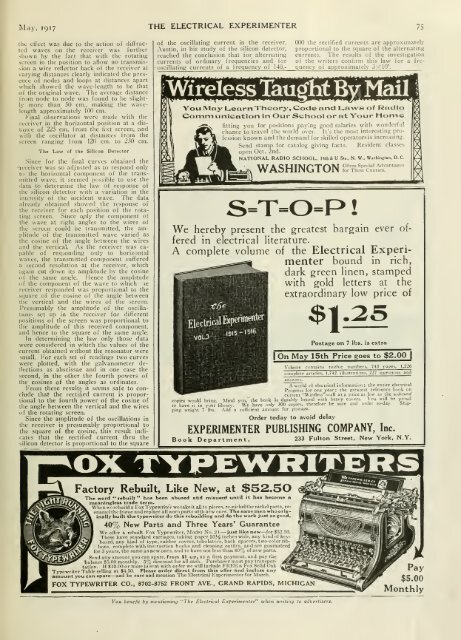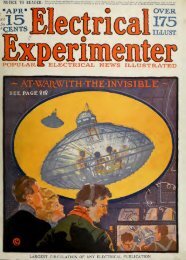The Electrical experimenter
The Electrical experimenter
The Electrical experimenter
Create successful ePaper yourself
Turn your PDF publications into a flip-book with our unique Google optimized e-Paper software.
May, 1917 THE ELECTRICAL EXPERIMENTER 75<br />
the clftct was due to the action of diffracted<br />
waves on the receiver was further<br />
-liown by the fact tliat witli the rotating<br />
screen in t'le position to allow no transmission<br />
a wire reflector back of the receiver at<br />
varying distances clearly indicated the presence<br />
of nodes and loops at distances apart<br />
wliich showed the wave-length to be that<br />
of the original wave. <strong>The</strong> average distance<br />
from node to node was found to be slightly<br />
more than 50 cm., making the wavelength<br />
approximately 10() cm.<br />
l-'inal observations were made with the<br />
receiver in the horizontal position at a distance<br />
of 225 cin. from the fixt screen, and<br />
with the oscillator at distances from the<br />
>creen ranging from 120 cm. to 230 cm.<br />
<strong>The</strong> Law of the Silicon Detector<br />
Since for the final curves obtained the<br />
-jeceiver was so adjusted as to respond only<br />
10 the horizontal component of the transmitted<br />
wave, it seemed possible to use the<br />
(lata to determine the law of response of<br />
the silicon detector with a variation in the<br />
intensity of the incident wave. <strong>The</strong> data<br />
already obtained showed the response of<br />
the receiver for each position of the rotating<br />
screen. Since ojily the component of<br />
the wave at right angles to the wires of<br />
the screen could be transmitted, the am-<br />
I)litnde of the transmitted wave varied as<br />
the cosine of the angle between the wires<br />
and the vertical. As the receiver was capable<br />
of responding only to horizontal<br />
waves, the transmitted component suffered<br />
a second resolution at the receiver, which<br />
again cut down its amplitude by the cosine<br />
of the same angle. Hence the amj>litude<br />
of the component of the wave to which ic<br />
receiver responded was proportional to the<br />
stpiare of the cosine of the angle between<br />
the vertical and the wires of the screen.<br />
Presumably the ainplitude of the oscillations<br />
set up in the receiver for different<br />
I)ositions of the screen was proportional to<br />
the amplitude of this received component,<br />
and hence to the square of the same angle.<br />
In determining the law only those data<br />
were considered in which the values of the<br />
current obtained without the resonator were<br />
small, l-'or each set of readings two curves<br />
were plotted, with the galvanometer dellections<br />
as abscissae and in one case the<br />
second, in the other the fourth powers of<br />
the cosines of the angles as ordinates.<br />
I'rom these results it seems safe to conclude<br />
that the rectified current is proportional<br />
to the fourth power of the cosine of<br />
the angle between the vertical and the wires<br />
of the rotating screen.<br />
Since the amplitude of the oscillations in<br />
the receiver is presumably proportional to<br />
the square of the cosine, this result indicates<br />
that the rectihed current thru the<br />
silicon detector is proportional to the square<br />
of the oscillating current in the receiver.<br />
.\ustin, in his study of the silicon detector,<br />
reached the conclusion that for alternating<br />
currents of ordinary frequencies and for<br />
ciscillating currents of a frequency of 140,-<br />
000 the rectified currents are approximately<br />
proportional to the square of the alternating<br />
currents. <strong>The</strong> results of the investigation<br />
of the writers confirm this law for a frequency<br />
of approximately 3X10'-<br />
1 IVliiy Learn <strong>The</strong>ory, Code and Laws of RatlU)<br />
nmunication in Our School or at Your Home<br />
fitting you for positions paying goo




